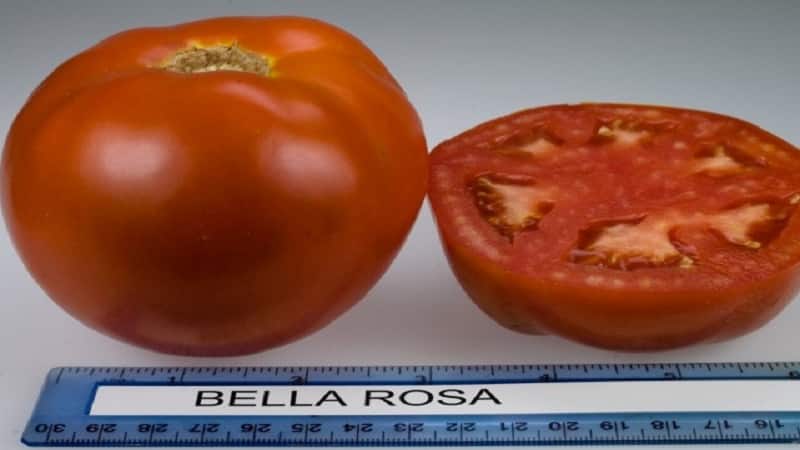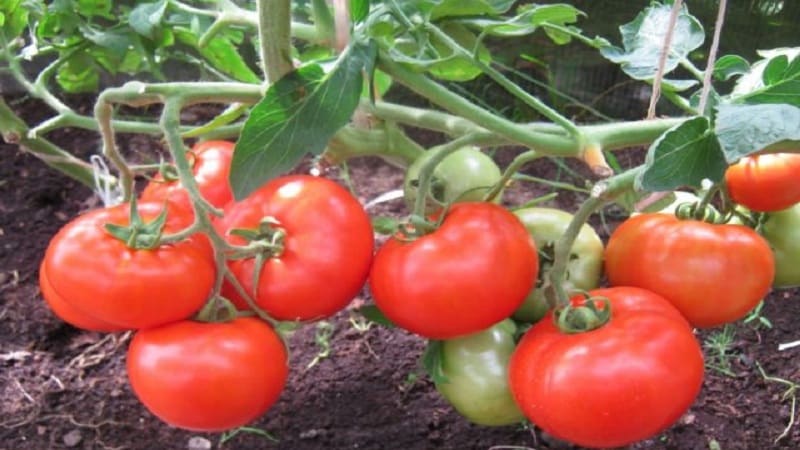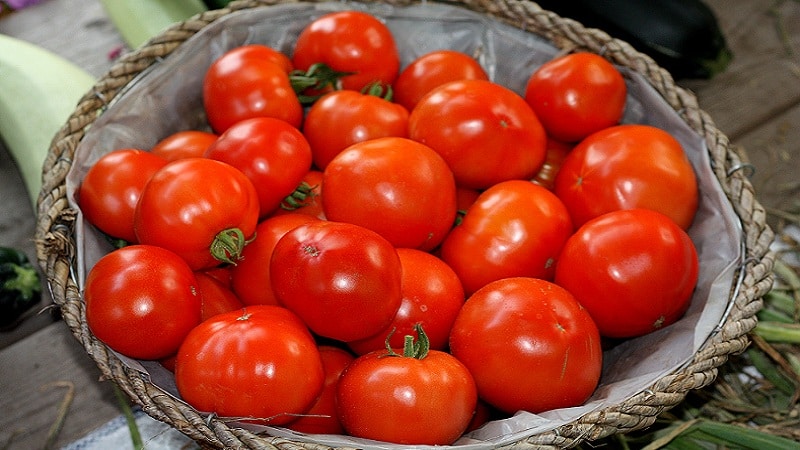Hybrid tomato "Bella Rosa" and how to grow it correctly
Tomato Bella Rosa f1 is a mid-season hybrid intended for outdoor cultivation in hot climates. Amazing taste qualities, rapid ripening, long-term fruiting and the ability to be transported over long distances allow it to maintain its position as a leader.
In this article we will talk about the nuances of cultivation, advantages and disadvantages of the crop.
Description of tomatoes
The Bella Rosa hybrid was included in the State Register of the Russian Federation in 2008. The breeding was carried out by the well-known company Sakata, which appeared on the seed market in 1913. The culture is suitable for cultivation in open ground or under temporary film cover. Determinate plants need staking and bush formation. Ideal growing conditions are Crimea, Kuban and Astrakhan region.
Pictured are Bella rosa tomatoes.

Table of distinctive features.
| Indicators | Characteristic |
| Fruit weight | 180–300 g |
| Form | The fruits are round, slightly flattened, slightly ribbed |
| Coloring | Red |
| Leaves | Medium size, light green color |
| Type of inflorescences | Intermediate |
| peduncle | With articulation |
| Pulp | Dense, meaty |
| Taste | Pleasant, sweet |
| Skin | Dense, does not crack |
| Purpose | For fresh consumption |
| Bush height | 65–100 cm |
| Ripening period | 98–105 days from emergence |
| Productivity | 4.9 kg per 1 m² |
| Sustainability | To verticillium, cladosporiosis, fusarium, nematodes |
| Planting Density | 4 bushes per 1 m² |
Advantages and disadvantages
The main advantages of the Bella Rosa hybrid:
- high productivity;
- simultaneous ripening of tomatoes;
- resistance to viruses;
- long shelf life;
- drought resistance;
- pleasant taste.
Among the disadvantages are:
- the need to adhere to a systematic regime of watering and fertilizing;
- whole fruits are not suitable for preservation;
- tomatoes are rarely used for purees and juice due to the large amount of dry matter (5-6%);
- bushes need garter;
- does not tolerate cold and sudden temperature fluctuations;
- It is not advisable to grow in greenhouses, since the stems stretch strongly upward, and the fruits grow small and lose their taste;
- susceptibility to bacterial infections.
How to grow
For successful cultivation of Bella Rosa, the manufacturer recommends following a number of rules:
- disinfection and germination of seeds before sowing;
- simultaneous stepsoning and gartering;
- removing side shoots 4-5 cm long until the first cluster appears;
- forming bushes in dry weather conditions to avoid fungal infection;
- moderate watering;
- compliance with the fertilizer application schedule (once every 3-4 days);
- prevention of bacterial diseases.
Sowing seeds
Seed material begins to be planted at the end of March or beginning of April, approximately 60 days before planting in open ground.
The seeds are disinfected in a pale pink solution of potassium permanganate for 30 minutes. Pre-germination helps to increase the percentage of germination. The seeds are laid out in one layer on one half of damp gauze, the other is covered and left for 2-3 days. The fabric is periodically moistened with warm water using a spray bottle.
For sowing, plastic containers, tetrapacks, and pots are used.Any soil for seedlings is suitable: from the garden or universal for growing flower plants. Drainage is poured into the bottom of the containers, then soil. Make furrows 1 cm deep and lay out the seeds at a distance of 2 cm. Cover with a thin layer of earth, water with a watering can and cover with plastic wrap.
Advice. It is recommended to pre-disinfect the soil from the garden in the oven.
Seedling care
Containers with future seedlings are placed in a shaded place, the film is removed from time to time for 10–15 minutes so that the soil does not become moldy. After the sprouts appear, the containers are taken to a well-lit place. If there is not enough sun, a phytolamp is additionally used. Moderate watering is necessary, the air temperature should not be lower than +15 ° C, otherwise the leaves will turn purple.
Planting into individual containers begins when the first true leaves appear. Peat cups are best suited; seedlings are planted directly into the ground in them.
Planting ready seedlings
The soil for planting seedlings begins to be prepared in the fall. The soil is dug up and weeds are removed along with their roots.
The transfer of seedlings is carried out in early May, making sure that the soil has warmed up sufficiently and the threat of frost has passed. The growing area must be sufficiently lit. Mullein is used as fertilizer. The holes are dug to a depth of 10–15 cm and filled with a solution of potassium permanganate. Planting density – 4 bushes per 1 m², distance – 50 cm.
Tomato care

Culture needs proper formation:
- Lateral stepsons, located under the inflorescences, are left.
- The main stem is pinched after the third leaf of the second inflorescence. Thus, the plant does not stretch in length, but grows in breadth and gains strength.
- As the plant grows, it is tied to a support so that the branches do not break under the weight of the fruit.
The best way to simplify plant care is mulch soil with sawdust, hay or pine needles. This slows down moisture evaporation and weed growth.
Tomatoes are watered as the soil dries - once every 7 days. During drought, the frequency of watering is increased to 3 times a week. Bella Rosa does not tolerate excess moisture well: the roots begin to rot, and the tomatoes become watery and sour.
Before flowering, add mineral feeding. Experienced farmers advise using superphosphate for this purpose. You should not get carried away with potassium fertilizers because of their ability to increase the level of chlorine in the soil, which negatively affects the taste of the fruit.
Next they switch to organic fertilizers (once every 3-4 days):
- compost;
- nettle infusion;
- wood ash;
- bird droppings.
To stimulate the growth and ovary of fruits, the following preparations are used: “Bud”, “Senior Tomato”, “Ovary”.
Advice. Watering and apply fertilizing exclusively at the root of the plant to prevent late blight infection.
How to fight diseases and insects
The Bella Rosa hybrid is protected at the genetic level from viral diseases, but is susceptible to bacterial damage, rot and insect attacks.
To combat slugs and spider mites, use soap, garlic or mustard solution, and decoctions of thyme, sage and lavender to wipe the leaves. Ash mixed with hot pepper is scattered around the bushes.
To prevent late blight, use:
- a solution of copper sulfate before flowering begins (for 10 liters of water, 2 tablespoons of copper sulfate);
- "Fitosporin" (diluted according to instructions);
- “Trichopol” (1 tablet per 1 liter of water);
- solution iodine with milk (9 liters of water + 1 liter of milk + 15 drops of iodine);
- hay tincture (infused in 10 liters of water with 2 tablespoons of urea for 4 days).
If infection cannot be avoided, diseased leaves and fruits are removed and burned, and the instrument is disinfected.
Disease prevention measures:
- Maintain a distance between seedlings (at least 50 cm).
- Mulching the soil.
- Removing the lower leaves.
- Moderate watering.
Reviews from gardeners

Bella Rosa is one of the best hybrids for growing in the southern regions of the country, as evidenced by positive reviews.
Valery, Korenovsk, Krasnodar region: “Bella Rosa started planting tomatoes back in 2010. I grow vegetables for sale in large quantities, and these tomatoes are the first to fly away. The fruits grow large, fleshy and very sweet. Primarily suitable for preparing salads. The crop does not require special care, the main thing is to fertilize it on time and water it moderately.”
Sofia, Tikhoretsk, Krasnodar region: “I have been looking for tomatoes for growing in our hot region for a long time. A friend advised me to buy Bella Rosa seeds. Last year I planted it and didn’t regret it. I have solid experience in growing tomatoes, so frequent feeding and monitoring the moisture level did not scare me. The harvest was collected until the onset of cold weather. The taste of the fruit is at the highest level.”
Boris, town. Liman, Astrakhan region: “I’ve been growing Bella Rosa tomatoes for a long time. According to the variety description on the package, the tomatoes correspond to reality. I'm always pleased with the result. Productivity – 5-6 kg per 1 m², fruiting is long and uniform. It is important to tie up the bushes in time so that the branches do not break under the weight of large fruits.”
Conclusion
Compliance with the rules of agricultural technology of the Bella Rosa hybrid (pinching, weeding, moderate watering, frequent fertilizing with organic and mineral substances, measures to prevent putrefactive lesions and insect attacks) allows you to obtain a rich harvest until the onset of cold weather.
There is only one thing that upsets us: the impossibility of cultivation in the northern regions in greenhouses due to the loss of the taste of tomatoes and stretching of the stems.